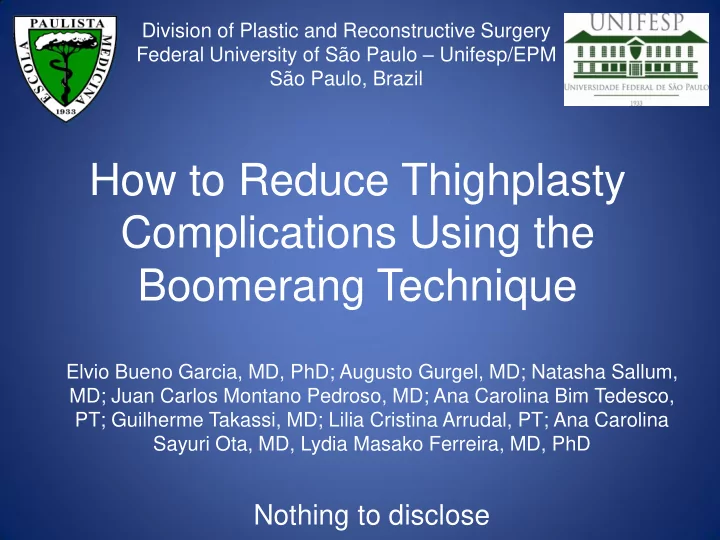

Division of Plastic and Reconstructive Surgery Federal University of São Paulo – Unifesp/EPM São Paulo, Brazil How to Reduce Thighplasty Complications Using the Boomerang Technique Elvio Bueno Garcia, MD, PhD; Augusto Gurgel, MD; Natasha Sallum, MD; Juan Carlos Montano Pedroso, MD; Ana Carolina Bim Tedesco, PT; Guilherme Takassi, MD; Lilia Cristina Arrudal, PT; Ana Carolina Sayuri Ota, MD, Lydia Masako Ferreira, MD, PhD Nothing to disclose
Introduction • Thighplasty in patients with massive weight loss (MWL) is a challenge for plastic surgeons • Usual surgical techniques have common complications – Bleeding – Infection – Bad scarring – Wound dehiscence – Seroma – Labial spreading
Objective • To describe a technique called Boomerang thighplasty and verify its effectiveness to treat thigh skin excess in patients with massive weight loss.
Material and Methods • 16 patients with MWL underwent Boomerang Thighplasty between March 2011 and August 2012 • All patients were followed monthly • On the 6 th month after surgery, patients answered a satisfaction questionnaire.
Preoperative Marking • A vertical, a diagonal and a transverse line Bisectrix 1 cm parallel to inguinal crease was drawn. • To draw a semicircular flap, bisectrix was marked until it met the anterior oblique line.
Preoperative Marking • A semicircle flap which radius was one third of Radius bisectrix was marked. The triangular marking without the circular flap represents the boomerang-like skin Boomerang-like resection excess resected.
Surgical Procedure • Excess skin and subcutaneous were resected preserving deep fascia. • The flap was not attached to the Colle’s fascia. • Suction drains were placed .
Results • There was no dehiscence, hematoma or infection. One patient presented seroma with satisfactory outcome. • Based patient’s on questionnaire, satisfaction reached the average grade 25,8 ± 3,8 (86%) from a total of 30 points. • Sensibility preservation, better mobility, ease in getting dressed and final cosmetic result presented the most positive data.
Results 14 Patients (n) Very good 12 10 Good 8 6 Bad 4 2 0
Results Before surgery 2 months after surgery
Considerations • In order to reduce complications, this study describes a thighplasty technique with a boomerang-like resection. • Final suture tension is reduced if a semicircular flap is preserved. We believe this implies lower complication rates and satisfactory aesthetic results.
Conclusion • Boomerang Thighplasty appeared to be an easy and reproducible technique with low complication rates and high satisfaction for surgical treatment in patients with massive weight loss.
Bibliography 1)Shermark MA, et al. Does thighplasty for upper thigh laxity after massive weight loss require a vertical incision? Aesthet Surg J. 2009 Nov-Dec;29(6):513-22. 2) Mathes DW, Kenkel JM. Current concepts in medial thighplasty. Clin Plast Surg. 2008 Jan;35(1):151-63. 3) Montano-Pedroso JC, Garcia EB, Omonte IR, Rocha MG, Ferreira LM. Hematological variables and iron status in abdominoplasty after bariatric surgery. Obes Surg. 2013 Jan;23(1):7-16. 4) Lewis JR jr. correction of ptosis of thighs: the thigth lift. Plast. Reconstr Surg 1966;37(6): 494-8 5) Lockwood TE. Facial anchoring technique in meidal thigh lifts. Plast Recontr Surg 1988;82 (2): 299-204 6) Lockwood T. Lower body Lift with medial fascial system suspension. Plast Resconstr Surg 1993; 92 (6): 1112- 22 7) Louran C, et al. The concentric medial thigh lift. Aesthetic Plast Surg. 2004 Jan-Feb;28(1):20-3 8) Hurwitz D. Medial Thighplasty Aesthetic Surg J 2005;25:180-191 9) Cram A, et al. Thigh reduction in the massive weight loss patient. Clin Plast Surg. 2008 Jan;35(1):151-63 10)Bozola A, et al. Suspensão composta glúteo-crural. Rev. Bras. Cir Plast. 2008; 23 (3): 189-91 11) Montenegro L, et al. Técnica do retalho triangular para cruroplastia medial pós grandes perdas ponderais em mulheres. Rev Bras Cir Plást. 2010; 25 (4): 700-4 12) Kenkel JM, et al. Medial thight lift. Plast Reconstr Surg. 2008; 35:73-91; discussion 93 13)Angela Y. Song, et al. A classification of contour deformities after bariatric wheith loss: The Pittsburg Rating Scale. Plast Reconstr Surg. 2005 Oct;116(5):1535-44; discussion 1545-6. 14) Alsarraf R. Outcomes research in facial plastic surgery. A review and a new directions. Aesthetic Plast Surg. 2000; 24(3):192-7 15) Modolin M. Técnica aprimorada de braquioplastia pós-bariátrica. Revista do Colégio Brasileiro de Cirurgiões. 2011; 38 (4) 120-125
Recommend
More recommend